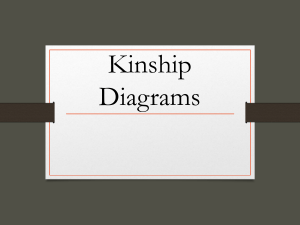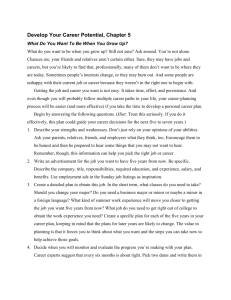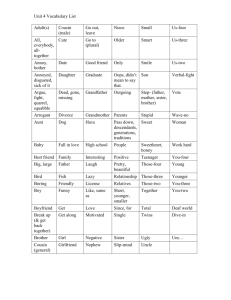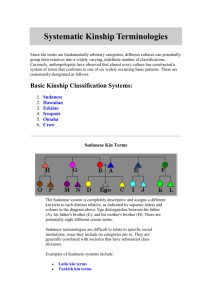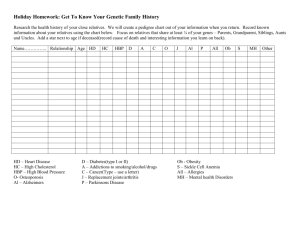th n A c
advertisement
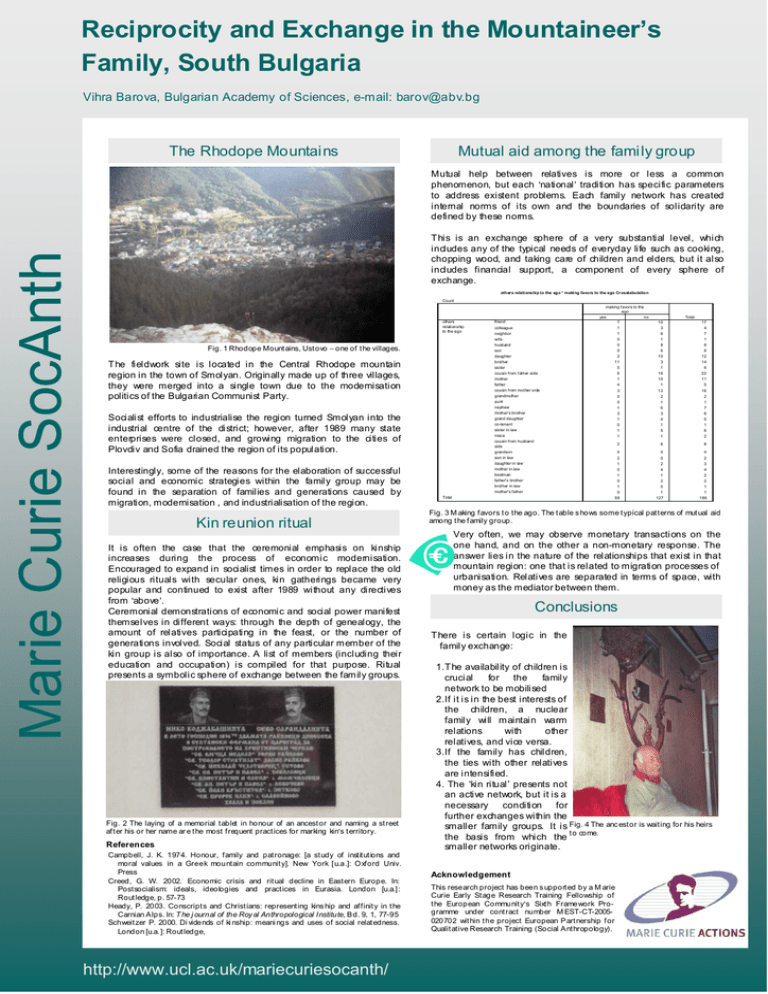
Reciprocity and Exchange in the Mountaineer’s Family, South Bulgaria Vihra Barova, Bulgarian Academy of Sciences, e-mail: barov@abv.bg The Rhodope Mountains Mutual aid among the family group Marie Curie SocAnth Mutual help between relatives is more or less a common phenomenon, but each national tradition has specific parameters to address existent problems. Each family network has created internal norms of its own and the boundaries of solidarity are defined by these norms. This is an exchange sphere of a very substantial level, which includes any of the typical needs of everyday life such as cooking, chopping wood, and taking care of children and elders, but it also includes financial support, a component of every sphere of exchange. others relationship to the ego * making favors to the ego Crosstabulation Count making favors to the ego no 7 1 1 0 0 0 2 11 5 6 1 4 3 0 0 1 3 1 0 1 1 yes others relationship to the ego Fig. 1 Rhodope Mountains, Ustovo one of the villages. The fieldwork site is located in the Central Rhodope mountain region in the town of Smolyan. Originally made up of three villages, they were merged into a single town due to the modernisation politics of the Bulgarian Communist Party. Socialist efforts to industrialise the region turned Smolyan into the industrial centre of the district; however, after 1989 many state enterprises were closed, and growing migration to the cities of Plovdiv and Sofia drained the region of its population. Interestingly, some of the reasons for the elaboration of successful social and economic strategies within the family group may be found in the separation of families and generations caused by migration, modernisation , and industrialisation of the region. Kin reunion ritual It is often the case that the ceremonial emphasis on kinship increases during the process of economic modernisation. Encouraged to expand in socialist times in order to replace the old religious rituals with secular ones, kin gatherings became very popular and continued to exist after 1989 without any directives from above . Ceremonial demonstrations of economic and social power manifest themselves in different ways: through the depth of genealogy, the amount of relatives participating in the feast, or the number of generations involved. Social status of any particular member of the kin group is also of importance. A list of members (including their education and occupation) is compiled for that purpose. Ritual presents a symbolic sphere of exchange between the family groups. Fig. 2 The laying of a memorial tablet in honour of an ancestor and naming a street after his or her name ar e the most frequent practices for marking kin s territory. References Campbell, J. K. 1974. Honour, family and patronage: [a study of institutions and moral values in a Greek mountain community]. New York [u.a.]: Oxford Univ. Press Creed, G. W. 2002. Economic crisis and ritual decline in Eastern Europe. In: Postsocialism: ideals, ideologies and practices in Eurasia. London [u.a.]: Routledge, p. 57-73 Heady, P. 2003. Conscripts and Christians: representing kins hip and affinity in the Carnian Alps. In: T he j ournal of the Roy al Anthropological Institute, Bd. 9, 1, 77-95 Schweitzer P. 2000. Di vidends of ki nship: meani ngs and uses of social relatedness. London [u.a.]: Routledge, http://www.ucl.ac.uk/mariecuriesocanth/ friend colleague neighbor wife husband son daughter brother sister cousin from father side mother father cousin from mother side grandmother aunt nephew mother's brother grand daughter co-tenant sister in law niece cousin from husband side grandson son in law daughter in law mother in law bestman father's brother brother in law mother's father Total Total 10 3 6 1 8 6 10 3 1 16 10 1 13 2 1 6 3 4 1 5 1 17 4 7 1 8 6 12 14 6 22 11 5 16 2 1 7 6 5 1 6 2 2 6 8 4 2 1 0 1 0 1 0 59 0 0 2 4 1 2 0 1 127 4 2 3 4 2 2 1 1 186 Fig. 3 M aking favors to the ago. The table s hows some typical patterns of mutual aid among the family group. Very often, we may observe monetary transactions on the one hand, and on the other a non-monetary response. The answer lies in the nature of the relationships that exist in that mountain region: one that is related to migration processes of urbanisation. Relatives are separated in terms of space, with money as the mediator between them. Conclusions There is certain logic in the family exchange: 1.The availability of children is crucial for the family network to be mobilised 2.If it is in the best interests of the children, a nuclear family will maintain warm relations with other relatives, and vice versa. 3.If the family has children, the ties with other relatives are intensified. 4. The kin ritual presents not an active network, but it is a necessary condition for further exchanges within the smaller family groups. It is Fig. 4 The anc estor is waiting for his heirs the basis from which the to come. smaller networks originate. Acknowledgement This research project has been s upported by a M arie Curie Early Stage Research Training Fellowship of the European Community s Sixth Framework Programme under contract number M EST-CT-2005020702 within the project European Partnership for Qualitative Research Training (Social Anthropology).
